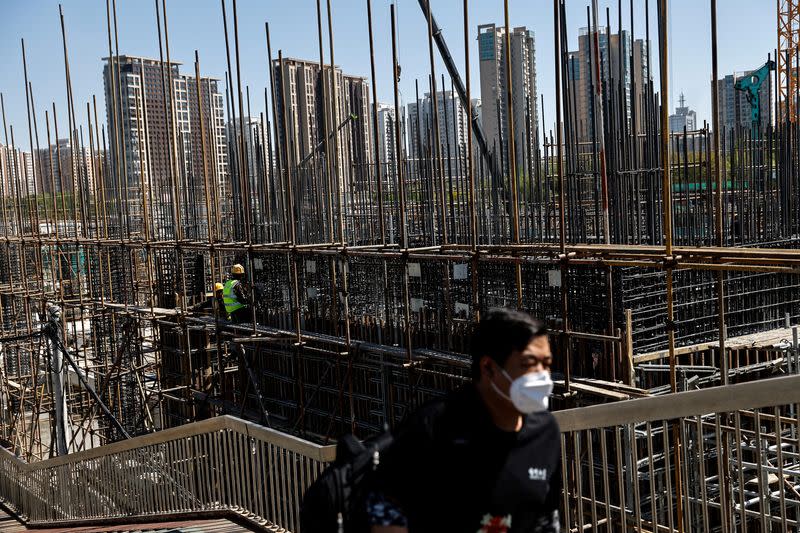China saw buoyant economic growth in the third quarter, with an improvement in consumption and industrial activity in September.
Figures released on Wednesday were better than expected. They suggest a recent flurry of policy measures helped to bolster a tentative recovery.
Rapidly weakening growth in the world’s second-biggest economy since the second quarter prompted authorities to step up their support steps, with Wednesday’s batch of data indicating the stimulus is starting to gain traction although a property crisis and other headwinds continue to pose risks to the outlook.
Gross domestic product (GDP) grew 4.9% in July-September from the year earlier, data released by the National Bureau of Statistics showed, versus analysts’ expectations in a Reuters poll for a 4.4% increase but slower than the 6.3% expansion in the second quarter.
ALSO SEE: China Asks Banks to Roll Over $13tn Local Debt at Lower Rates
On a quarter-by-quarter basis, GDP grew 1.3% in the third quarter, accelerating from a revised 0.5% in the second quarter and above the forecast for growth of 1.0%.
“It seems that all of that stimulus is finally beginning to take effect, with a broad beat from growth, retail sales, industrial production and unemployment,” said Matt Simpson, senior market analyst at City Index in Brisbane.
The government is walking a tightrope as it tries to restore economic equilibrium, with policymakers having to navigate a domestic property crisis, high youth unemployment, depressed private sector confidence, a slowdown in global growth and Sino-US tensions over trade, technology and geopolitics.
Beijing has in recent weeks unveiled a raft of measures, but its ability to spur growth has been hamstrung by fears over debt risks and a fragile yuan, which has been hit hard this year due to widening yield differentials as global interest rates remain elevated, led by the Federal Reserve’s tightening campaign.
Asian stocks pared their losses after the better-than-expected China data, while the yuan and trade-dependent Australian and New Zealand dollars all bounced. The yuan hit a one-week high of 7.2905 per dollar.
Factory output and retail sales rise in September
The recovery momentum suggests the government’s full year 2023 growth target of around 5.0% is likely to be achieved.
“The improvement in Q3 economic data makes it less likely for the government to launch stimulus in Q4, as the growth target of 5% is set to be achieved,” Zhiwei Zhang, chief economist at Pinpoint Asset Management, said.
“The focus of the government and the market will shift to the growth outlook for next year. The key issue is what growth target the government will set and how much fiscal easing will take place.”
The statistics bureau said China would be able to hit the 2023 growth target if the fourth quarter growth tops 4.4%.
Industrial output in September grew a stronger than expected 4.5% from a year earlier, but the pace was unchanged from August, according to the separate data. Analysts had expected a 4.3% increase.
Growth of retail sales, a gauge of consumption, also beat expectations, rising 5.5% last month, and accelerating from a 4.6% increase in August. Analysts had expected retail sales to expand 4.9%.
Fixed asset investment grew 3.1% in the first nine months of 2023 from the same period a year earlier, versus expectations for a 3.2% rise. It expanded 3.2% in the January-August period.
Worries over property crisis
But a deepening downturn in the property sector, which accounts for nearly a quarter of economic output, poses a big challenge to policymakers as they seek to keep growth on track, analysts said.
The latest data underlined those worries. Property investment in the first nine months of 2023 fell by 9.1% from a year earlier, after slumping 8.8% in January-August. Fixed-asset investment by private firms fell 0.6% in January-September year-on-year, highlighting weak private sector confidence.
The faltering property sector has hit some of the biggest developers in the country.
A grace period for a $15 million coupon payment by Country Garden Holdings, China’s biggest private property developer, expired earlier in the day, fuelling fears that it had defaulted on its offshore debt.
“In the grand scheme of things, I don’t think individual developers running into further financial turbulence will be enough to derail things. The problems of the developers have been known to the market for some while now,” Frederic Neumann, chief Asia economist and co-head of Global Research at HSBC, said.
All the same, efforts by policymakers to support big cities have failed to bolster confidence, underscoring the depth of the problems in the industry which slumped into a crisis two years ago.
“In the near-term, our expectations are still for a further round of 10bp rate cuts in Q4 from the PBOC, a step-up in the easing of home-buying restrictions, and modest increases in state-directed infrastructure spending,” Louise Loo, China economist at Oxford Economics, said in a note.
The International Monetary Fund on Wednesday downgraded its 2023 and 2024 growth forecasts for the Asian giant, saying the property slowdown could cause China’s GDP to decline.
- Reuters with additional editing by Jim Pollard
ALSO SEE:
Country Garden’s $17bn Offshore Debt on Verge of Default
Baidu Claims Its Latest Ernie AI Is a Match for ChatGPT
China Boosts Liquidity Support But Weak Yuan Fears Weigh
Fears of China’s ‘Japanization’ Weigh On Asia Economic Outlook
























